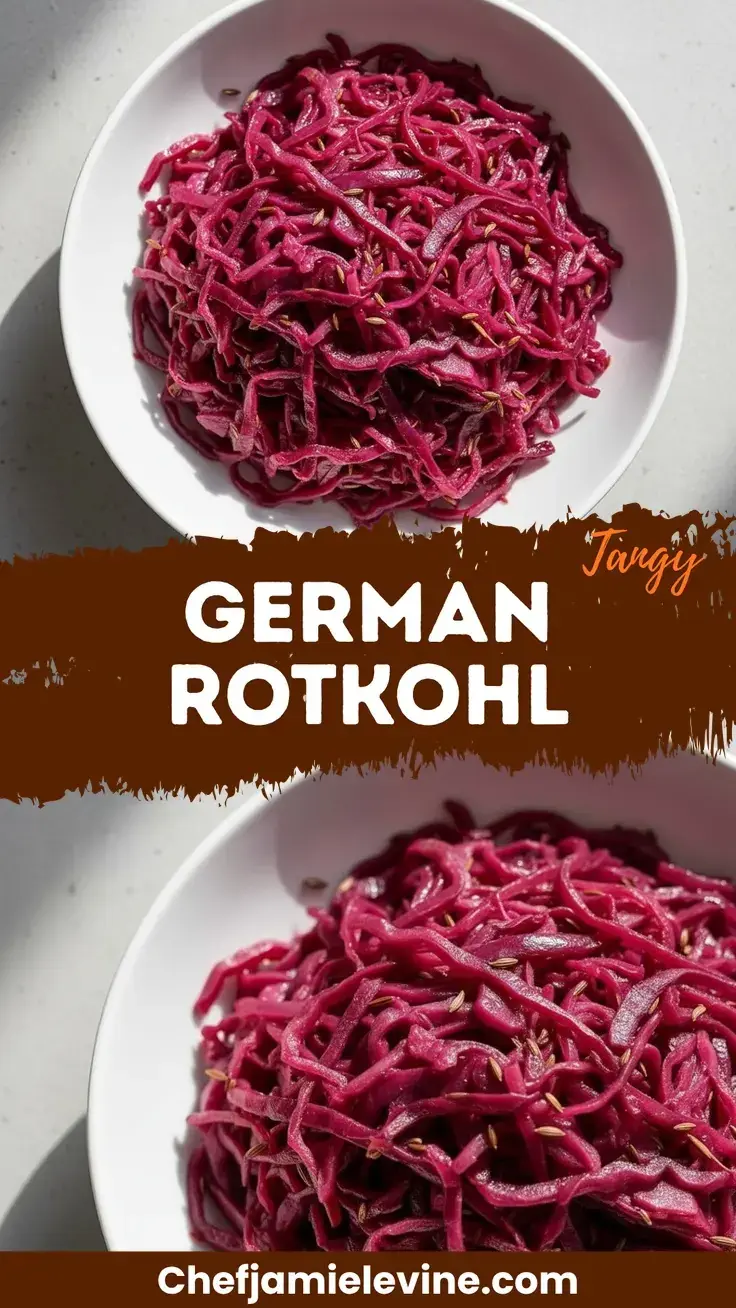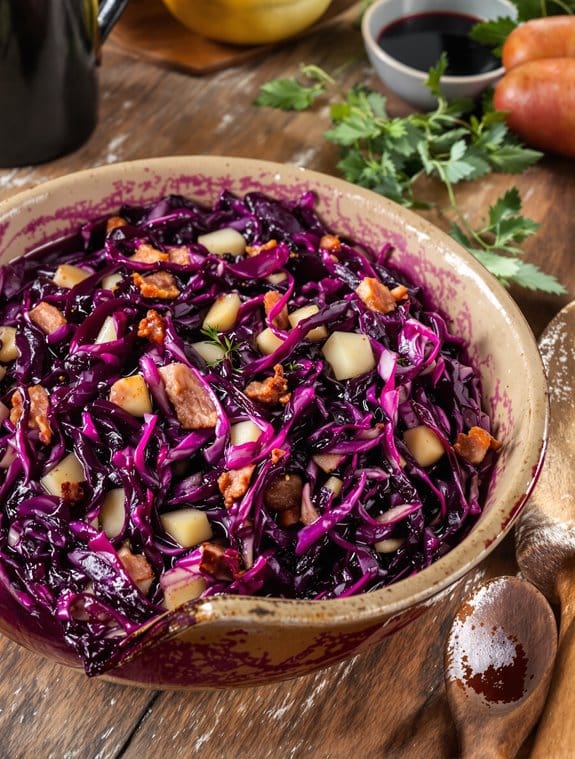Why You’ll Love this Sweet-Tangy Red Cabbage
Whether you’re craving an authentic German side dish or simply looking to add color to your dinner table, this sweet and tangy Rotkohl will quickly become a family favorite.
I love how the bacon adds a smoky depth while the apples balance the vinegar with natural sweetness.
What makes this dish special? The way the cabbage transforms during cooking—softening while maintaining just enough texture. The deep purple hue isn’t just gorgeous; it’s practically guaranteed to impress guests.
My German grandmother taught me that good Rotkohl needs time for the flavors to meld.
Trust me, the leftovers taste even better the next day.
What Ingredients are in Sweet-Tangy Red Cabbage?
To create this vibrant German classic, you’ll need a handful of simple ingredients that work together to create that perfect balance of sweet and tangy flavors. The magic of Rotkohl comes from the combination of smoky bacon, tart apples, and the deep purple cabbage that gives this dish its signature color. What I find fascinating about traditional German recipes like this one is how they transform humble ingredients into something truly special.
- 2 slices bacon, diced
- 2 cups green apples, peeled and diced
- 4 cups red cabbage, rinsed, cored and shredded
- 2 tablespoons vinegar
- 1/4 cup beef stock
- 1/2 cup dry red wine
- 1 tablespoon sugar
- Salt and pepper to taste
When shopping for these ingredients, the quality of your red cabbage makes a big difference—look for heads that feel heavy for their size with crisp, vibrant leaves. And while the recipe calls for green apples, Granny Smiths are ideal for their tartness. Can you substitute the bacon? Sure, but that smoky flavor really does elevate the dish. For vegetarians, a splash of liquid smoke might work, though you’d need to use vegetable stock instead of beef. The dry red wine adds depth, but in a pinch, you could use additional stock plus a touch more vinegar.
How to Make this Sweet-Tangy Red Cabbage

Making authentic Rotkohl couldn’t be simpler, and the layering of flavors creates something truly magical in your kitchen. Start by heating a skillet over medium heat and sautéing 2 slices of diced bacon until they become soft but not crispy. The rendered fat creates an incredible flavor base that’s absolutely worth the extra calories—trust me on this one.
Once your bacon has softened, it’s time to add the remaining ingredients all at once: 2 cups of peeled and diced green apples, 4 cups of rinsed, cored, and shredded red cabbage, 2 tablespoons of vinegar, 1/4 cup of beef stock, 1/2 cup of dry red wine, and 1 tablespoon of sugar.
Give everything a good stir to combine, then bring the mixture to a boil. This initial high heat helps to jump-start the cooking process and begins to break down the cabbage’s structure. After it reaches a boil, reduce the heat to a simmer, cover the skillet, and let everything cook together for about 15 minutes, or until the cabbage reaches your desired tenderness. Some folks prefer their cabbage with a bit more bite, while others like it meltingly soft—I’m somewhere in the middle myself.
The final touch is simply seasoning with salt and pepper to taste. This is where you can really make the dish your own. Need a bit more sweetness? Add a pinch more sugar. Want more tang? A splash of extra vinegar works wonders.
The beauty of Rotkohl is how the flavors meld and deepen as they sit, which is why many German families make this dish a day ahead. The cabbage’s vibrant purple will intensify, staining everything in the pan with that gorgeous jewel tone that makes this side dish such a showstopper alongside roasted meats or sausages.
Sweet-Tangy Red Cabbage Substitutions and Variations
While traditional Rotkohl holds a special place in German cuisine, you can easily adapt this recipe to suit your pantry and personal preferences.
Don’t have bacon? Try butter with a dash of smoked paprika for that smoky essence. Apple cider vinegar works perfectly if you’re out of regular vinegar, and vegetable stock can replace beef stock for my vegetarian friends.
The wine adds depth, but grape juice with a splash of extra vinegar makes a fine alcohol-free substitute. I sometimes toss in cranberries during fall or add a cinnamon stick for warmth.
My grandmother would be horrified, but even she couldn’t resist these tasty variations.
What to Serve with Sweet-Tangy Red Cabbage
Rotkohl’s vibrant purple hue and sweet-tangy flavor create the perfect sidekick for countless German classics.
I love serving it alongside a juicy bratwurst or schnitzel, where the cabbage’s acidity cuts through the richness of the meat. It’s absolutely divine with sauerbraten or any roasted pork dish.
Want something a bit different? Try pairing it with roast duck or goose during the holidays. The sweet-tart flavor balances the fatty poultry beautifully.
For a complete German feast, add some spätzle or potato dumplings to soak up all those delicious juices. Trust me, once you’ve tried this combination, you’ll wonder how you ever lived without it.
Final Thoughts
Although it may seem like a simple side dish, this authentic Rotkohl recipe has become one of my most treasured culinary keepsakes.
I’ve served it at holiday dinners, casual weeknight meals, and everything in between. There’s something magical about the way the sweet apples balance the tangy vinegar, creating that distinctive flavor that transports me straight to my grandmother’s kitchen.
What I love most? It’s forgiving. Made too much? It tastes even better the next day.
Need to prep ahead? No problem. This vibrant dish has stood the test of time in my kitchen for good reason.

German Rotkohl Recipe: Sweet-Tangy Red Cabbage
Ingredients
Equipment
Method
- Heat a skillet over medium heat and sauté the diced bacon until soft but not crispy.
- Add the peeled and diced green apples, shredded red cabbage, vinegar, beef stock, dry red wine, and sugar to the skillet.
- Stir thoroughly to combine all ingredients.
- Bring the mixture to a boil, then reduce heat to a simmer.
- Cover the skillet and let everything cook together for about 15 minutes, or until the cabbage reaches your desired tenderness.
- Season with salt and pepper to taste before serving.



